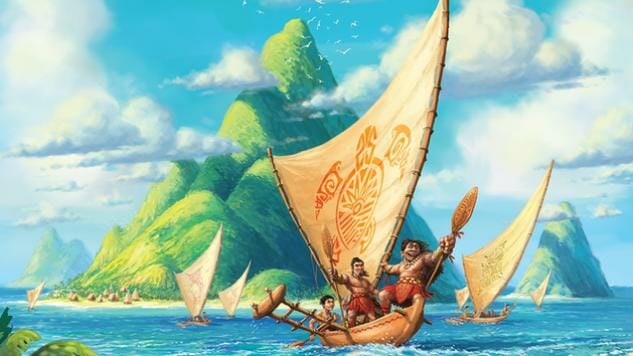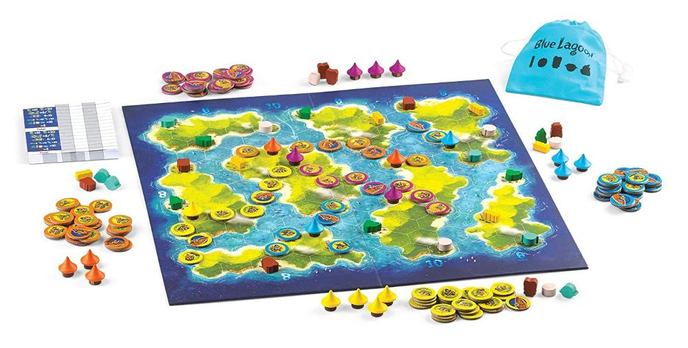Reiner Knizia’s Blue Lagoon Is a Great Addition to Your Board Game Collection
Games Reviews board games
A new Reiner Knizia game is always newsworthy; he’s the most prolific designer in the field, and several of his games stand as all-time classics, including the intense strategy games Tigris & Euphrates and Samurai, as well as the lighter two-player games Battle Line and Lost Cities. He’s still churning out new titles, but hasn’t had as many hits recently, aside from the 2017 Spiel des Jahres nominee The Quest for El Dorado. His newest release, Blue Lagoon, looks to me like his best game in quite some time, a new spin on another of his greatest hits, Through the Desert, that plays a little faster and trades off some of that game’s conflicts for resource collection and a requirement that you balance multiple paths to scoring.
Blue Lagoon has two rounds, played similarly but where some of your moves in the first round have a critical effect on the second. The board is covered with hexagonal spaces that include eight islands and narrow (one hex) waterways between them. There are also five types of resources scattered across the islands, four of which score in sets, with the fifth (statues) scoring just based on the number you collect. Each player starts with a set of settler tokens and five village tokens, and on a turn, may place a new settler on any water hex, or may place a settler or village on land next to any one of that player’s tokens already on the board. If you place a token on a space with a resource, you get the resource for that round. Play continues until all resources are gathered or all tokens placed, at which point there’s a full scoring. Players score if they managed to get at least one token on seven or eight of the islands; for the number of islands in their longest consecutive chain of tokens; for having the most tokens on each island (six, eight or ten points); and for the resources—complete sets of four, for having two or more of any regular resource type, and for statues. It’s a little point salad-y, which isn’t great, but the different ways you score end up strongly influencing placement decisions throughout the game, and encourage you to think about making certain moves to block off opponents near the end of each round.
After round one, players retrieve all of their settler tokens but not villages (unless you placed a village on a resource space, which is legal but not a good move because you lose it after round one). All resources are returned to the game’s bag and randomly redistributed on the board. In round two, players may only place tokens next to one of their villages or settlers already on the board—so you can’t place settlers directly on any waterway unless it’s adjacent to something of yours. This is the genius of Knizia’s design here: when you place tokens in round one, you have to consider when and where to place villages to set yourself up in round two; but the random redistribution of the resource and statue tokens also allows players who fall behind in scoring after round one to make big moves in round two anyway, if they’re clever and focus on gathering the right ones. The specifics of the scoring look complicated on the scoring pad, since there are six different ways to earn points, but there’s an inherent logic to what Blue Lagoon rewards, indicative of the way Knizia designs his games around the underlying math first, with the theme coming second.
The resources are finite and their distribution creates an inherent competitive aspect on the Blue Lagoon board, which is then heightened by the scoring of each of the eight islands: the player with the most tokens (settlers or villages) on each island gets six, eight or 10 points, depending on the island’s size. That makes placing your last few tokens in each round more than just a cursory exercise—if you can’t get more resources, you’ll find yourself looking for opportunities to ‘steal’ an island’s points—and also provides a reason to create chains of your own tokens to block or slow other players’ progress. You can even set yourself up so that one or two resource tokens are only available to you, and then take your time before claiming them since you know you have them on lockdown.
Blue Lagoon is definitely on the lighter side of Euro-style games, even with the point salad scoring; it plays in about a half an hour once everyone knows the rules, as turns can take just a few seconds and you can plan ahead a few moves at a time. The scoring is the only reason it might give younger players any trouble, but you could certainly let kids play by simpler rules so they’re not left out. Blue Lagoon doesn’t break any new ground, even within Knizia’s own library of designs—Through the Desert also involves building chains on a board of hexes and collecting items for points; Tigris & Euphrates and Samurai have related but more complex area-control mechanisms—so experienced gamers might find it too familiar. For families or folks who just prefer light, quick game experiences, however, it’s a great new addition to a collection.
Keith Law is a senior baseball writer for ESPN.com and an analyst on ESPN’s Baseball Tonight. You can read his baseball content at search.espn.go.com/keith-law and his personal blog the dish, covering games, literature, and more, at meadowparty.com/blog.
